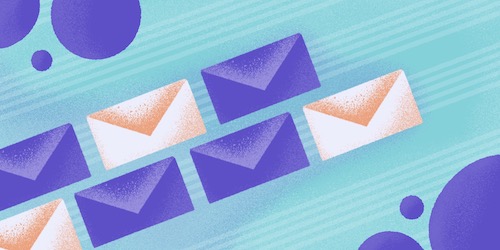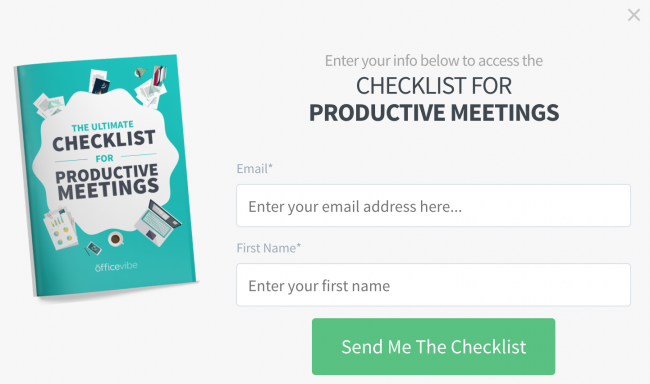Your Absolute Guide to Email Marketing for Your Store

Email marketing is one of the most effective ways to turn prospects into customers, and it’ll help you turn one-time customers into fiercely loyal customers as well.
You don’t need to take our word for it—study after study has shown that email marketing produces a higher conversion rate and ROI compared to social media marketing, paid search ads and other popular marketing mediums.

Another benefit of email marketing is that, unlike advertising on social media and other platforms, everything is within your control. You’ll never need to worry about your strategy being thrown off by someone else (Google, Facebook, Twitter, etc.) changing up their policies. It’s just you and the customer.
So, are you ready to get started with email marketing yet? In this guide, we’ll take you through building your contact list, writing the perfect marketing email and everything else you need to know.
#cta-visual-pb#<cta-title>Build a better Shopify store<cta-title>Make your store look and feel as unique as your brand by customizing with the best page builder for Shopify.Start building for free
Building out your email list
Before you can start sending out your marketing emails, you’ll need a list of contacts to send them to.
You should never buy an email list from a third party. First of all, sending messages to such a list is unlikely to lead to much sales. Most of these people will not be familiar with your brand, and the data from these lists is often outdated and inaccurate. In fact, using a third-party email list will make many people less likely to buy from you in the future, as their first impression of your business will be that you blindly sent them spam.
Also, many email services have policies for penalizing or outright banning users that they detect using third-party email lists. It just isn’t worth it.
Creating lead magnets
Indeed, you can’t just buy contacts — you’ll need to earn them yourself, and lead magnets are the best tool for this task.
A lead magnet is something that you give away for free in exchange for the visitor’s email address. This could be anything from an eBook to a webinar to a free trial of your latest product.
Whatever form your lead magnet takes, the key is to make sure that it actually provides value to the visitor. Regurgitating information that can easily be found elsewhere isn’t good enough. You’ll need original research, unique insights, custom graphics, etc. to entice visitors enough to give up their contact information.
Opt-in form design
The design of your opt-in form also has an effect on how many people will end up giving you their email address. With the following tips, you’ll be able to encourage more visitors to send over their info:
- Concise headline: Attention spans are short these days. The fewer words in your headline, the better. You can also highlight the most important words in your headline with bold or large font to make it even more digestible.
- Only ask for the basics: The number of fields on your form should also be kept short. Otherwise, the visitor might feel that it takes too long to fill out, which very well may lead to them backing out instead.
- Visual aid: Depicting the value of digital goods like eBooks can be difficult. It just doesn’t feel the same as exchanging physical goods. So, you should add a picture of the cover of your eBook (or some other visual aid if you’re using a different type of lead magnet) to make it seem more tangible.
- Highlight the CTA button: After the visitor fills out your form, you’ll need them to click on your CTA button in order to actually get their information. You can get more clicks by simply making the CTA button stand out — make the button large compared to other elements on the page and use a color that pops out from the background.

Segmenting your list
Not all of your contacts are the same, of course. They belong to different demographic groups and have different interests. They also have different relationships with your brand: some are long-time customers, while others haven’t even made a single purchase from you yet.
Given that fact, why would you treat all of your contacts the same?
Segmentation is the practice of breaking your contact list up into smaller sub-groups. That way, you can send messages that are more personalized and relevant (and therefore, more effective) to each group.
How to write the perfect marketing email
In the segmentation section above, we touched on the fact that successful email marketing efforts require some degree of personalization. The type of copy that works well for one group might not be effective for another.
That said, here are a few general writing tips that apply to just about every type of marketing email:
- Be concise, but not curt: You’re lucky enough to get a subscriber to open your email (expect your average open rate to be between 15% to 25%). If someone opens your message only to be greeted with a long wall of text, they likely won’t proceed any further. Keep it short and focus on the value of your offer. Be careful not to come off as rude, though — it’s also important to maintain a friendly, conversational tone.
- Act like you’re writing to one person: It may seem strange when you’re sending a message to thousands of subscribers, but your email should read as if it’s being sent to only one person. Frequently use the second-person “you” to address the reader directly.
- Use humor: Jokes, GIFs and memes will make your messages feel more personal and less business-oriented. If you can manage to make your emails genuinely funny, it will encourage subscribers to keep opening your emails, and it’ll improve your brand’s overall reputation as well.
Choosing the best email marketing platform
Once your number of subscribers reaches the hundreds (let alone the thousands), email marketing software is all but necessary for keeping your contacts organized and tracking the performance of your campaigns.
While there are many viable email marketing platforms out there, the following services stand out as being especially good options:
- Mailchimp: It should be no surprise that the most popular email marketing platform is also one of the most affordable services available. If you have fewer than 2,000 contacts, you can use this service for free.
- GetResponse: While not quite as affordable as Mailchimp (prices start at $15 per month), what makes GetResponse uniquely attractive is that it has software specifically designed for hosting webinars. If you plan to use webinars as a lead magnet, this option must be strongly considered.
- Campaigner: This option is the crème de la crème of email marketing platforms. Prices start at $49.95 per month, but for that cost you get 900+ templates and a state-of-the-art email builder, which provides you with a high degree of freedom for customizing your messages.
And email marketing platforms can do much more than just help you design your emails, organize your contacts and track your campaigns. When determining which service you will pick for your business, you should keep an eye out for these advanced features:
- A/B testing: The email marketing tips covered in this guide are generally helpful, but you won’t know what really works for your contact list until you try it out. A/B testing allows you to send different versions of an email to the same segment at the same time, so you can objectively determine which techniques work best for your subscribers.
- Autoresponders: With automated messages that are triggered by predetermined events (welcome emails, order notifications, abandoned cart reminders, etc.), you’ll be able to engage your customers without sacrificing any of your time.
- Send time optimization: It can be difficult to decide when to send your messages out. You don’t want to send them when your subscribers aren’t active online, but you should also avoid times that are so busy your emails might get buried by other messages. This is what makes send time optimization, which involves your email marketing service determining the best time to send your messages based on how subscribers have historically responded to your campaigns, such a useful feature.
Email marketing is one of the most effective ways to make more ecommerce sales. If you haven't already, start building your email list today.
#cta-visual-pb#<cta-title>Build a better Shopify store<cta-title>Make your store look and feel as unique as your brand by customizing with the best page builder for Shopify.Start building for free

Adam Ritchie
Adam Ritchie is a writer based in Silver Spring, Maryland. He writes about ecommerce trends and best practices for Shogun. His previous clients include Groupon, Clutch and New Theory.



